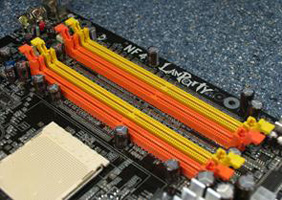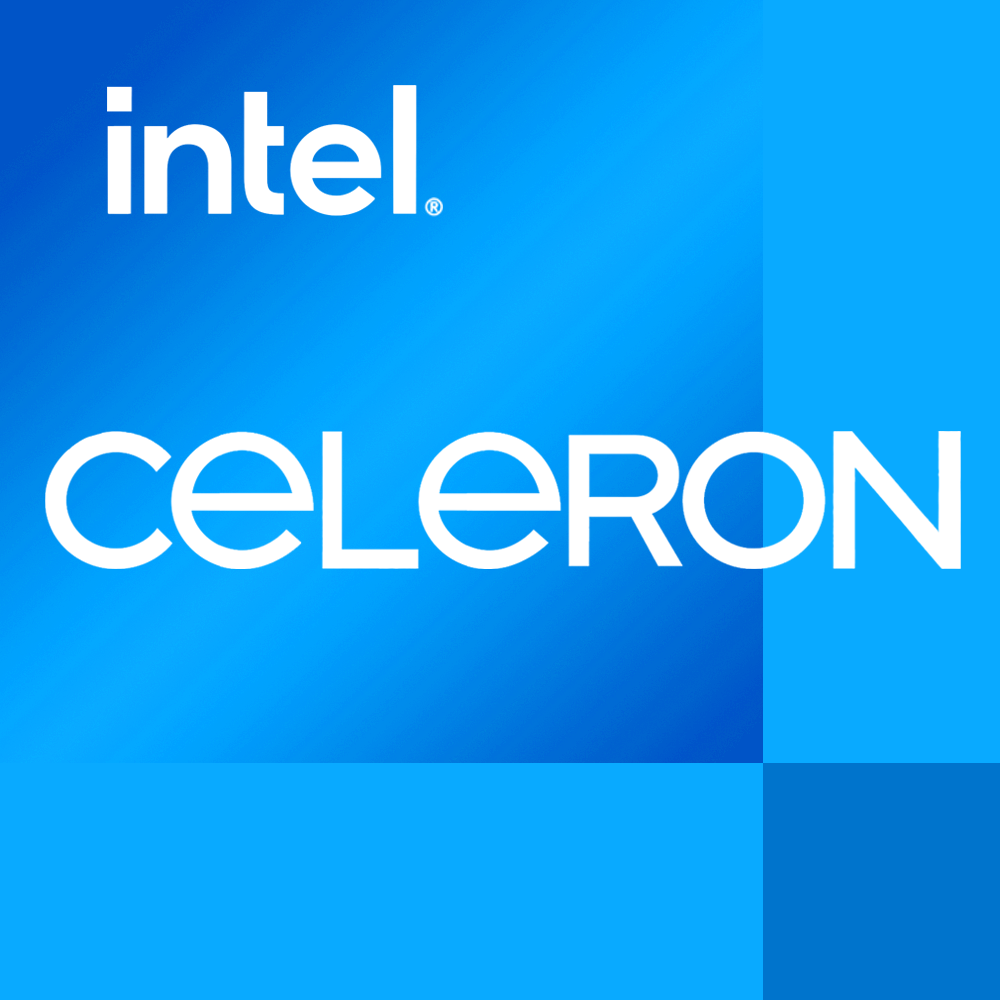|
Socket G1
Socket G1, also known as rPGA 988A, is a CPU socket introduced by Intel in 2009 for the mobile variants of the first-generation Intel Core processors. It is the successor to Socket P, and the mobile counterpart to LGA 1156 and LGA 1366. History The first CPUs for the Socket G1 platform were released on September 23, 2009, in the form of the i7-720QM, 820QM, and 920XM. These CPUs use the Clarksfield core, which maintained the same 45 nm manufacturing process as the desktop Nehalem architecture. On January 4, 2010, the range was expanded with Core i3, i5, and i7 processors using the 32 nm Arrandale core and based on the Westmere architecture. On March 28, 2010, low-end Arrandale-based CPUs were released as the Pentium P6x00 series and Celeron P4x00 series. Further Clarksfield-based processors were released as the i7-740QM, 840QM, and 940XM on June 21, 2010. All Socket G1 processors have the Intel HD Graphics Ironlake core packaged onto the CPU substrate. Supported processors ... [...More Info...] [...Related Items...] OR: [Wikipedia] [Google] [Baidu] |
Pin Grid Array
A pin grid array (PGA) is a type of integrated circuit packaging. In a PGA, the package is square or rectangular, and the pins are arranged in a regular array on the underside of the package. The pins are commonly spaced 2.54 mm (0.1") apart, and may or may not cover the entire underside of the package. PGAs are often mounted on printed circuit boards using the through hole method or inserted into a socket. PGAs allow for more pins per integrated circuit than older packages, such as dual in-line package (DIP). PGA variants Plastic Plastic pin grid array (PPGA) packaging was used by Intel for late-model Mendocino core Celeron processors based on Socket 370. Some pre-Socket 8 processors also used a similar form factor, although they were not officially referred to as PPGA. Flip chip A flip-chip pin grid array (FC-PGA or FCPGA) is a form of pin grid array in which the die faces downwards on the top of the substrate with the back of the die exposed. This allows ... [...More Info...] [...Related Items...] OR: [Wikipedia] [Google] [Baidu] |
32 Nm Process
The 32 nm node is the step following the 45 nm process in CMOS ( MOSFET) semiconductor device fabrication. "32- nanometre" refers to the average half-pitch (i.e., half the distance between identical features) of a memory cell at this technology level. Toshiba produced commercial 32GiB NAND flash memory chips with the 32nm process in 2009. Intel and AMD produced commercial microchips using the 32-nanometre process in the early 2010s. IBM and the Common Platform also developed a 32 nm high-κ metal gate process. Intel began selling its first 32 nm processors using the Westmere architecture on 7 January 2010. The 28-nanometre node was an intermediate half-node die shrink based on the 32-nanometre process. The 32 nm process was superseded by commercial 22 nm technology in 2012. [...More Info...] [...Related Items...] OR: [Wikipedia] [Google] [Baidu] |
List Of Intel Processors
This generational list of Intel processors attempts to present all of Intel's processors from the pioneering 4-bit 4004 (1971) to the present high-end offerings. Concise technical data is given for each product. Latest 13th generation Core Desktop (codenamed "Raptor Lake") 12th generation Core Desktop (codenamed "Alder Lake") Mobile (codenamed "Alder Lake") 11th generation Core Desktop (codenamed "Rocket Lake") Mobile (codenamed "Tiger Lake") 10th generation Core Desktop (codenamed "Comet Lake") Mobile (codenamed "Comet Lake", " Ice Lake", and " Amber Lake") 9th generation Core Desktop (codenamed "Coffee Lake Refresh") 8th generation Core Desktop (codenamed "Coffee Lake") Mobile (codenamed "Coffee Lake", " Amber Lake" and " Whiskey Lake") 7th generation Core Desktop (codenamed "Kaby Lake" and "Skylake-X") Mobile (codenamed "Kaby Lake" and " Apollo Lake") All processors All processors are listed in chron ... [...More Info...] [...Related Items...] OR: [Wikipedia] [Google] [Baidu] |
Triple-channel Architecture
In the fields of digital electronics and computer hardware, multi-channel memory architecture is a technology that increases the data transfer rate between the DRAM memory and the memory controller by adding more channels of communication between them. Theoretically, this multiplies the data rate by exactly the number of channels present. Dual-channel memory employs two channels. The technique goes back as far as the 1960s having been used in IBM System/360 Model 91 and in CDC 6600. Modern high-end desktop and workstation processors such as the AMD Ryzen Threadripper series and the Intel Core i9 Extreme Edition lineup support quad-channel memory. Server processors from the AMD Epyc series and the Intel Xeon platforms give support to memory bandwidth starting from quad-channel module layout to up to octa-channel layout. In March 2010, AMD released Socket G34 and Magny-Cours Opteron 6100 series processors with support for quad-channel memory. In 2006, Intel released chipsets t ... [...More Info...] [...Related Items...] OR: [Wikipedia] [Google] [Baidu] |
Dual-channel Architecture
In the fields of digital electronics and computer hardware, multi-channel memory architecture is a technology that increases the data transfer rate between the DRAM memory and the memory controller by adding more channels of communication between them. Theoretically, this multiplies the data rate by exactly the number of channels present. Dual-channel memory employs two channels. The technique goes back as far as the 1960s having been used in IBM System/360 Model 91 and in CDC 6600. Modern high-end desktop and workstation processors such as the AMD Ryzen Threadripper series and the Intel Core i9 Extreme Edition lineup support quad-channel memory. Server processors from the AMD Epyc series and the Intel Xeon platforms give support to memory bandwidth starting from quad-channel module layout to up to octa-channel layout. In March 2010, AMD released Socket G34 and Magny-Cours Opteron 6100 series processors with support for quad-channel memory. In 2006, Intel released chipsets that s ... [...More Info...] [...Related Items...] OR: [Wikipedia] [Google] [Baidu] |
List Of Intel Celeron Processors
The Celeron is a family of microprocessors from Intel targeted at the low-end consumer market. CPUs in the Celeron brand have used designs from sixth- to eighth-generation CPU microarchitectures. Desktop processors P6 based Celerons Celeron ''(single-core)'' = "Covington" (250 nm) = * All models support: '' MMX'' * Steppings: A0, A1, B0 = "Mendocino" (250 nm) = * All models support: '' MMX'' * L2 cache is on-die, running at full CPU speed = "Coppermine-128" (180 nm) = * All models support: '' MMX, SSE'' = "Tualatin-256" (130 nm) = * Family 6 model 11 * All models support: '' MMX, SSE'' Netburst based Celerons Celeron ''(single-core)'' = " Willamette-128" (180 nm) = * Family 15 model 1 * All models support: '' MMX, SSE, SSE2'' * Steppings: E0 = " Northwood-128" (130 nm) = * Family 15 model 2 * All models support: '' MMX, SSE, SSE2'' * Steppings: C0, C1, D0, D1, D4, DD Celeron D ''(single core)'' = " Prescott-256" (90 ... [...More Info...] [...Related Items...] OR: [Wikipedia] [Google] [Baidu] |
List Of Intel Pentium Processors
The Intel Pentium brand is a line of mainstream x86-architecture microprocessors from Intel. Processors branded Pentium Processor with MMX Technology (and referred to as Pentium MMX for brevity) are also listed here. Desktop processors P5 based Pentiums "P5" (0.8 μm) * Based on P5 * Steppings: B1, C1, D1 "P54C" (0.6 μm) * Based on P5 microarchitecture "P54CQS" (0.35 μm or 0.6 μm) * Based on P5 microarchitecture "P54CS" (0.35 μm) * Based on P5 microarchitecture "P55C" (0.35 μm) * Based on P5 microarchitecture P6 based Pentiums Desktop processors based on the P6 microarchitecture were marketed as Pentium Pro, Pentium II and Pentium III, as well as variations of these names. NetBurst based Pentiums Desktop processors based on the NetBurst microarchitecture were marketed as Pentium 4 and Pentium D. Core based Pentiums Earlier E5xxx desktop processors based on the Core microarchitecture were marketed as Pentium ... [...More Info...] [...Related Items...] OR: [Wikipedia] [Google] [Baidu] |
List Of Intel Core I3 Processors
The following is a list of Intel Core i3 brand microprocessors. These processors are designed with cheap price points, while still retaining the power of the Intel Core line. As such they (along with Intel's i5 series) are often found in laptops and low-end desktop computers. Desktop processors Westmere microarchitecture (1st generation) " Clarkdale" ( MCP, 32 nm) * All models support: '' MMX, SSE, SSE2, SSE3, SSSE3, SSE4.1, SSE4.2, Enhanced Intel SpeedStep Technology (EIST), Intel 64, XD bit (an NX bit implementation), Intel VT-x, Hyper-Threading, Smart Cache.'' * FSB has been replaced with DMI. * Contains a GPU on a secondary die manufactured in 45 nm codenamed " Ironlake". ** Graphics and Integrated Memory Controller transistors: 177 million ** Graphics and Integrated Memory Controller die size: 114 mm² * Transistors:947 million * Die size: 81 mm² * Stepping: C2, K0 Sandy Bridge microarchitecture (2nd generation) "Sandy Bridge" (32 nm) ... [...More Info...] [...Related Items...] OR: [Wikipedia] [Google] [Baidu] |
List Of Intel Core I5 Processors
The following is a list of Intel Core i5 brand microprocessors. Introduced in 2009, the Core i5 line of microprocessors are intended to be used by mainstream users. Desktop processors Nehalem microarchitecture (1st generation) "Lynnfield" (45 nm) * All models support: '' MMX, SSE, SSE2, SSE3, SSSE3, SSE4.1, SSE4.2, Enhanced Intel SpeedStep Technology (EIST), Intel 64, XD bit (an NX bit implementation), Intel VT-x, Turbo Boost, Smart Cache.'' * FSB has been replaced with DMI. * Transistors: 774 million * Die size: 296 mm² * Stepping: B1 Westmere microarchitecture (1st generation) " Clarkdale" ( MCP, 32 nm dual-core) * All models support: '' MMX, SSE, SSE2, SSE3, SSSE3, SSE4.1, SSE4.2, Enhanced Intel SpeedStep Technology (EIST), Intel 64, XD bit (an NX bit implementation), TXT, Intel VT-x, Intel VT-d, Hyper-threading, Turbo Boost, AES-NI, Smart Cache.'' * Core i5-655K, Core i5-661 does not support ''Intel TXT and Intel VT-d.'' * Core i5-655K ... [...More Info...] [...Related Items...] OR: [Wikipedia] [Google] [Baidu] |
List Of Intel Core I7 Processors
The following is a list of Intel Core i7 brand microprocessors. Introduced in 2008, the Core i7 line of microprocessors are intended to be used by high-end users. Desktop processors Nehalem microarchitecture (1st generation) "Bloomfield" (45 nm) * All models support: MMX, SSE, SSE2, SSE3, SSSE3, SSE4.1, SSE4.2, Enhanced Intel SpeedStep Technology (EIST), Intel 64, XD bit (an NX bit implementation), Intel VT-x, Hyper-threading, Turbo Boost, Smart Cache. * FSB has been replaced with QPI. * Transistors: 731 million * Die size: 263 mm * Steppings: C0, D0 "Lynnfield" (45 nm) * All models support: MMX, SSE, SSE2, SSE3, SSSE3, SSE4.1, SSE4.2, Enhanced Intel SpeedStep Technology (EIST), Intel 64, XD bit (an NX bit implementation), TXT, Intel VT-x, Intel VT-d, Hyper-threading, Turbo Boost, Smart Cache. * Core i7-875K features an unlocked multiplier and does not support Intel TXT and Intel VT-d. * FSB has been replaced with DMI. *Moves the QPI link and PCI ... [...More Info...] [...Related Items...] OR: [Wikipedia] [Google] [Baidu] |
Intel GMA
The Intel Graphics Media Accelerator (GMA) is a series of integrated graphics processors introduced in 2004 by Intel, replacing the earlier Intel Extreme Graphics series and being succeeded by the Intel HD and Iris Graphics series. This series targets the market of low-cost graphics solutions. The products in this series are integrated onto the motherboard, have limited graphics processing power, and use the computer's main memory for storage instead of a dedicated video memory. They are commonly found on netbooks, low-priced laptops and desktop computers, as well as business computers which do not need high levels of graphics capability. In early 2007, about 90% of all PC motherboards sold had an integrated GPU. History The GMA line of GPUs replaces the earlier Intel Extreme Graphics, and the Intel740 line, the latter of which was a discrete unit in the form of AGP and PCI cards with technology that evolved from companies Real3D and Lockheed Martin. Later, Intel integrated ... [...More Info...] [...Related Items...] OR: [Wikipedia] [Google] [Baidu] |
Westmere (microarchitecture)
Westmere (formerly Nehalem-C) is the code name given to the 32 nm die shrink of '' Nehalem''. While sharing the same CPU sockets, Westmere included Intel HD Graphics, while Nehalem did not. The first ''Westmere''-based processors were launched on January 7, 2010, by Intel Corporation. The Westmere architecture has been available under the Intel brands of Core i3, Core i5, Core i7, Pentium, Celeron and Xeon. Technology Westmere's feature improvements from Nehalem, as reported: * Native six-core (Gulftown) and ten-core (Westmere-EX) processors. * A new set of instructions that gives over 3x the encryption and decryption rate of Advanced Encryption Standard (AES) processes compared to before. ** Delivers seven new instructions (AES instruction set or AES-NI), out of which six implement the AES algorithm, and PCLMULQDQ (see CLMUL instruction set) implements carry-less multiplication for use in cryptography and data compression. * Integrated graphics, added into the processor p ... [...More Info...] [...Related Items...] OR: [Wikipedia] [Google] [Baidu] |
_CPU-pins_PNr°0295.jpg)



